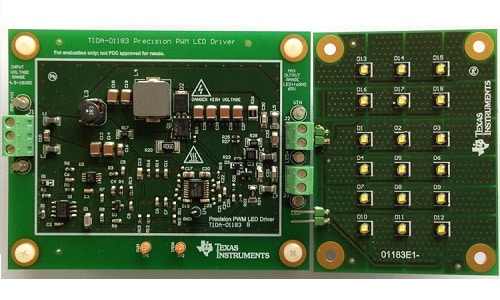Reference design for a pulse width modulation (PWM) based dimming LED driver for front or tail LED lights of a vehicle.

Electric vehicles run on batteries and therefore the system engineers try to optimize each and every system to reduce energy consumption. Therefore, it is important to optimise the power consumption of each and every system including the tail and front lights. So, if you want to have control over the intensity and brightness and power consumption of your LED light then this reference design will help you do just that.
The TIDA-01183 by TI is a reference design that allows you to utilise PWM to dim an automotive front or tail light with a precision of more than 2% duty cycle. The reference design doesn’t requires a microcontroller which reduces both the cost and complexity of the design. The reference design can directly be powered by the 12-volt car battery and works at the complete range of automotive battery conditions from 5V (simulating a cold crank) to 18V. This reference design is capable of running a string of up to 12 LEDs and offers output protection against short-to-battery and GND voltage. The block diagram of the reference design is shown in the image below:

The reference design employs a TPS92691-Q1 multi-topology LED driver in boost and boost-to-battery configuration to control the LEDs and the TLC555-Q1 LinCMOS timer together with the OPA2377-Q1 operational amplifier to measure and generate the accurate PWM signal by applying a feedback loop and a precision shunt regulator for setting the accurate duty cycle. The design includes key peripherals like electromagnetic interference (EMI) and electromagnetic compatibility (EMC) filtering-voltage-conditioning (shunt regulator), precision clock generation, and LED drive.
TI has tested this reference design. It comes with comprehensive software, firmware libraries, tools, battery, etc. You can find additional data about the reference design on the company’s website. To read more about this reference design click here.








